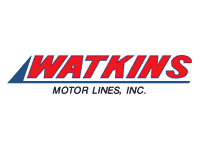 FedEx Corp. is buying Watkins Motor Lines -- the largest privately run less-than-truckload carrier in the nation -- and the best ticket it has for bulking up in a market showing impressive gains.
FedEx Corp. is buying Watkins Motor Lines -- the largest privately run less-than-truckload carrier in the nation -- and the best ticket it has for bulking up in a market showing impressive gains. Neither FedEx or Watkins would confirm details, but sources say FedEx will announce the acquisition -- internally dubbed "Convoy" -- as early as June 1.
Analysts say the price could range up to $1 billion.
Watkins, about a third the size of FedEx Freight, gives the division 139 terminals, 10,000 employees and trailers, 3,400 tractors and all its customers across its North American network.
"If the deal does take place, Watkins gives FedEx the ability to build density and do long haul, which is where Watkins is strongest," said Satish Jindel, transportation analyst in Pittsburgh.
The buy would also give FedEx Freight seamless services into Mexico and Canada -- which it now serves through contractors -- and a truckload division.
Last year, Watkins' revenue exceeded $1 billion, up more than 7 percent from 2004.
"Most of FedEx Freight's business is one-, two- or three-day. But in the last few years, customers have been wanting them to do longer-haul stuff," said Art Hatfield, Morgan Keegan analyst.
"Watkins is more set up for long-haul distances."
The less-than-truckload (LTL) leader is YRC Worldwide -- formerly Yellow Freight Corp. -- which controls about 30 percent of the roughly $35 billion LTL market.
No. 2 and No. 3 are Con-Way and FedEx Freight. The acquisition would move FedEx Freight firmly to the No. 2 spot.
Family-owned Watkins, based in Lakeland, Fla., has emerged as one of the nation's 10 largest LTL carriers in a period of intense carrier consolidation.
"At first, you saw regional companies merging to get a national presence," Hatfield said.
"Now, you have some who want to consolidate to improve their market share and service offerings."
And just as attractive to FedEx is the fact that Watkins is a nonunion carrier, one of a small handful of LTLs -- with origins mostly in the South -- "that has survived as nonunion companies," said Dick Armstrong, principal in Armstrong Associates in Stoughton, Wis.
"The long and short of it is that the W2 wages for a nonunion LTL driver are going to be about $45,000 a year. Union drivers are going to make more."
Although diesel prices have more than doubled since 2003, the shortage of truck drivers is now driving many of the big decisions in trucking companies.
"You can't shave costs on salaries now. Fuel may be precious but drivers are more precious," Armstrong said.
Volume in the less-than-truckload industry is growing about 3 to 5 percent a year. Revenue is up slightly more, but still easily outpacing the nation's economic growth.
Factors feeding the push include shippers' wish for "just in time" delivery, which saves them inventory and insurance costs.
Changes in Department of Transportation rules limiting the hours truckers can be on the job have pushed some long-haul business to the LTL carriers.
FedEx is a relative newcomer to the LTL business. In 1997, it acquired Viking Freight though its purchase of Caliber Systems.
"Viking allowed FedEx to get experience in the LTL business. They liked it so much, they bought American Freightways in 2000," Jindel said.
In 2002, FedEx rebranded the companies under its own name -- one of the five most recognized companies in the nation -- and watched sales accelerate.
In 2005, FedEx Freight's LTL revenue was up 19.6 percent to $2.8 billion.
"FedEx used technology, marketing and pricing discipline to to bring the margins up. But they also started offering customers bundled services, saying 'I can take your parcels and your freight too,' " Jindel said.
For customers, it meant better service. Invoicing that used to go to several now could go to one.
UPS didn't have an LTL carrier until it bought Overnite in 2005 to get into the game..
"It's too early to tell how it's doing because there is a time lag to put your services in place and leverage the brand," Jindel said.
"So far, Overnite has not done for UPS what FedEx Freight did for FedEx."
Watkins is part of Watkins Industries, which includes SunCo Carriers Inc., an LTL with refrigerated trailers; Watkins Canada Express Inc., Land Span, the truckload line; and Highway Transport Inc., a line of tanker trucks.

